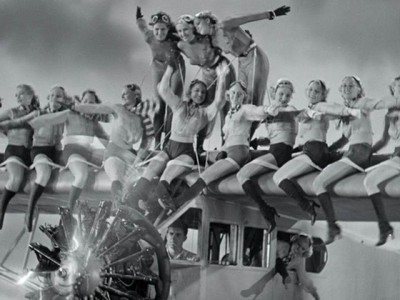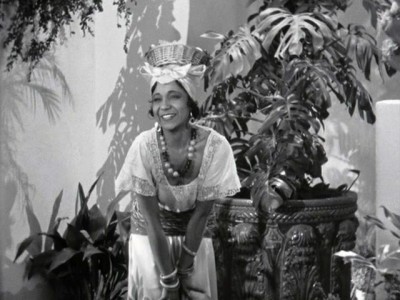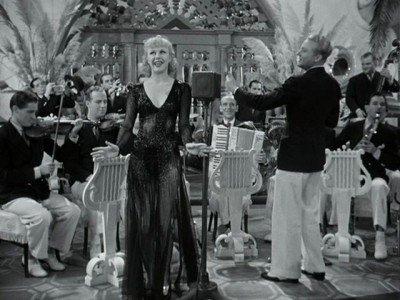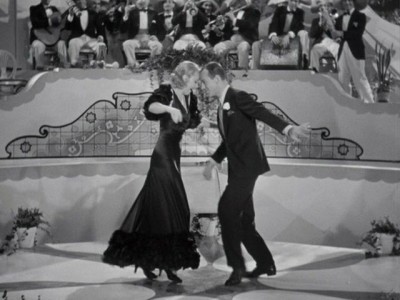
Since Thornton Freeland’s Flying Down to Rio introduced the world to the team of Fred Astaire and Ginger Rogers, it’s certainly not obscure. But because they are supporting players and dance together only twice — and only briefly — it’s by no means an Astaire-Rogers vehicle (and not as much revived as their more mature movies). That’s unfortunate because the movie has a lot to recommend it on other fronts, even though it’s obvious that the studio really had no idea what they had. (What is remarkable is that the public immediately knew that this pair was something special.) As with most musicals, the plot isn’t much — a hackneyed romance involving a high-class heiress (Dolores del Rio), her betrothed (Raul Roulien) and a snappy bandleader (Gene Raymond) — but it’s functional enough to house the songs and comedy. The film boasts four songs — “Music Makes Me” (sung by Rogers and later danced to by Astaire), “Orchids in the Moonlight” (sung by Roulien and danced to by del Rio and Astaire), “Carioca” (sung by Alice Gentle, Movita and Etta Moten, and danced by Astaire, Rogers and chorus), “Flying Down to Rio” (sung and danced to by Astaire with chorus participation).

Three of the songs are winners (“Orchids in the Moonlight” is a forgettable ballad). From an Astaire-Rogers standpoint, the main feature is the “Carioca,” which is the only occasion where the two dance together (in two separate bits). It’s also very well accomplished overall — the editing and use of camera are as good as anything Busby Berkely did. The film has its own distinctive look — probably owing more to uncredited effects pioneer and inventor Linwood G. Dunn than director Thornton Freeland. This film was one of the first to take advantage of his refinements to the optical printer that not only had much to do with the aerial effects in Flying Down to Rio, but also allowed for all those elaborate optical wipes used over the credits and in the scene transitions.

Plus, it gives us one of the two instances where the movies captured the luminous Etta Moten. She walks on and absolutely owns the screen for her few moments of singing the “Carioca,” making you long for her to return and wish she’d been in more films. But all we have are this and her rendition of “Remember My Forgotten Man” in Golddiggers of 1933 — probably totaling less that five minutes of screen time. But I doubt anyone who has seen those five minutes has ever forgotten them. (Considering she lived to be 102, there certainly was time for her to be in more films, but it just didn’t happen.) The big scene that everyone remembers, though, is “Flying Down to Rio” with its scantily-clad (some of those see-through blouses might as well not be there) chorus girls on the wings of airplanes. It certainly earns its place in the most memorable moments of film. Overall, the movie is a stylish delight and very much pre-code in its borderline nudity and racy dialogue (“What have these South Americans got below the equator that we haven’t?” asks a girl at one point).

Also worth noting is the sound of the film — by which I mean the orchestrations. This is one of the last movies — there’s a little of it in the first “real” Astaire-Rogers film The Gay Divorcee (1934) — that has this kind of 1920s jazz dance-band sound. And it’s probably the best recorded. It’s hard to explain, but you’ll notice that the music is anything but subdued and smoothed out. Everyone is playing in a style that can best called flat-out-and-wide-open — with a driving rhythm and a very insistent bass (tuba) part. Soon tastes would change and this rougher sound would be a thing of the past, which I think is a pity. All the same, it’s captured here for all time. (Or as long as the movies last.)
The Asheville Film Society will screen Flying Down to Rio Tuesday, Feb. 26 at 8 p.m. in the Cinema Lounge of The Carolina Asheville and will be hosted by Xpress movie critics Ken Hanke and Justin Souther.




Before you comment
The comments section is here to provide a platform for civil dialogue on the issues we face together as a local community. Xpress is committed to offering this platform for all voices, but when the tone of the discussion gets nasty or strays off topic, we believe many people choose not to participate. Xpress editors are determined to moderate comments to ensure a constructive interchange is maintained. All comments judged not to be in keeping with the spirit of civil discourse will be removed and repeat violators will be banned. See here for our terms of service. Thank you for being part of this effort to promote respectful discussion.